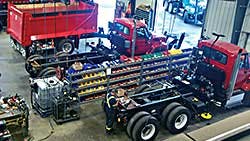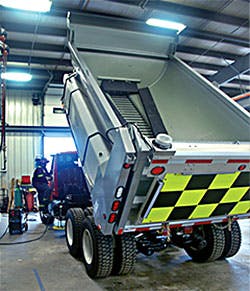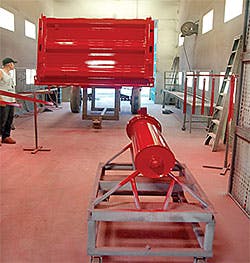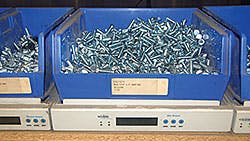Gin-Cor has a 400,000-square-mile sales area. Here’s how they serve it
THE job sounds simple: cover the territory. But the territory is huge, and the company is small.
That’s the challenge for Gin-Cor Industries, a truck equipment distributor in Mattawa, Ontario, some 250 miles north of Toronto. But with some new ideas, the territory does not seem quite as large. And by increasing its sales by 200% over the last five years, the company doesn’t seem nearly as small.
For many of its key product lines, Gin-Cor is responsible for all of the province of Ontario. Sure, most of the population—40% of the people living in Canada—live near the southern border. But that’s not where Gin-Cor lives, and it’s not how the company operates. If you are responsible for parts, sales, and service, you cover the entire territory.
Ontario contains more than 400,000 square miles, with major cities ranging from Ottawa on the east to Windsor on the west—an area larger than the state of Texas. And the farther north, the fewer the people. Yet there is still demand for the construction and plow trucks that Gin-Cor produces. And with those sales comes demand for aftermarket parts.
To do a more thorough job of covering Ontario, Gin-Cor has been branching out in two ways. The first is to open branch locations. The company now has two of them—one near Ottawa to serve eastern Ontario and another on the northeast shore of Lake Ontario to serve the southern part of the province. But Gin-Cor also has signed up two subdealers to handle parts sales—one in far western Ontario near the Manitoba border and another in the east to further serve the Ottawa area.
The parts subdealers, both of them independent businesses, have been partners with Gin-Cor since 2013.
“The idea came about as a result of a commitment we made to improve our parts and service presence,” says Luc Stang, president of Gin-Cor. “We needed a way to do a better job of serving our key suppliers and some of our major end user accounts who operate in some of the more remote areas of Ontario. Those customers needed an easier way to get parts and service for their equipment.”
Gin-Cor serves two radically different markets, and the parts subdealers help the company serve both of them. One of the subdealers, Resource Equipment Sales, is in Dryden, Ontario, two hours north of International Falls, Minnesota. The location, in the heart of Ontario’s mining operations, could best be described as remote.
The second subdealer, HW Bruce Sales, is in Gloucester, Ontario, an urban area near the nation’s capital. Gin-Cor needed the Dryden subdealer to serve a remote location. The Gloucester subdealer teams up with a Gin-Cor branch to help meet parts demand in and around Canada’s capital city.
“Our two locations in the Ottawa area complement one another, rather than compete,” Stang says. “Like many major cities, Ottawa has its share of traffic. It doesn’t matter if the customer is involved in construction or plow trucks. Our parts customers don’t want to drive across town. Our two locations make it much more convenient for our customers.”
What’s expected
At Gin-Cor, parts are a key for supporting the company’s line of specialized products that are targeted primarily for the construction, crane and snow control markets. The parts department does not stock a wide range of parts, but the inventory is deep. If a Gin-Cor customer needs a part within the markets that the company serves, management expects it to be there. Even with a relatively narrow focus, the parts department has 4,800 skus. Gin-Cor values its inventory at approximately $2.7 million.
“Our markets are pretty specialized, but it’s impressive how many proprietary parts are required, especially when you represent multiple manufacturers.” Stang says. “And we believe that if we sell something, we need to have the parts for it. We consider the parts side of every product we distribute. It’s a significant commitment.”
The two parts subdealers help make those parts available to customers who Gin-Cor would otherwise have difficulty reaching.
“Our business is very seasonal—construction in the spring and snowplow trucks in the fall,” Stang says. “Demand for those parts will fluctuate during the year, and it’s important that our parts subdealers have the parts in stock when the customer needs them.”
The remote locations of some Gin-Cor customers also make it challenging to provide them with quick parts delivery. From a practical standpoint, overnight delivery services often are unable to get it there that fast and often require two days.
“Our parts subdealers actively sell, promote, and deliver parts within a 200-mile radius of their location,”Stang says.
So how do the parts subdealers benefit from their partnership with Gin-Cor? For its part, Gin-Cor provides the subdealers discounts on inventory as well as marketing resources and sales leads for potential parts and/or equipment customers. Gin-Cor parts subdealers handle parts sales, but they also can provide service and some installations.
Gin-Cor does not expect its parts subdealers to stock a vast inventory. The company simply wants to make sure that the people who buy the specialized trucks that Gin-Cor upfits are able to get the parts required to keep those trucks running.
Over the years, Gin-Cor has expanded its product lines, in large part to level out demand for the niche markets that it serves.
Gin-Cor has been around since 1978. The company started by upfitting trucks for the forestry industry.
“The logging business can be feast or famine,” Stang says. “We began looking for a direction where we could branch out.”
That direction came early in the company’s history when truck dealers approached the young truck upfitter and asked if Gin-Cor could handle dump bodies. Taking on dump bodies proved to be a good choice. The company has been focusing on dump bodies since the early 1980s.
“We are Bibeau’s largest distributor,” Stang says.
Continued diversification
Of course, the dump body business is also seasonal. Since demand is high for dump trucks in the spring, the company once again began looking for products that would help make demand more consistent year-round. The answer to counterbalance its spring sales surge, the company concluded, was to get into the snow and ice control products.
Gin-Cor bought a snowplow manufacturer and began producing them at the Mattawa facility.
“Getting into this segment of the truck equipment business was good for us, but manufacturing was not really our strength,” Stang says. “We are at our best as distributors, upfitters not as manufacturers. That has been our focus for the past 14 years.”
Today the company represents a variety of manufacturers, including Viking-Cives. The relationship with Viking is an interesting one.
“We serve as a distributor for them, but we also assemble trucks for them,” Stang says. “Sometimes they are our supplier. Other times they are our customer.”
Geography drives the roles. Viking headquarters is Mount Forest, Ontario, in the southern part of the province. Gin-Cor covers the rest. Depending on the circumstances, Gin-Cor sometimes does the installation for Viking.
The company has upfitted approximately 6000 trucks since the mid-1980s.
Acquiring Durabody
Gin-Cor further diversified this spring, acquiring a truck body and trailer manufacturing company April 22.
Durabody Industries Ltd builds truck bodies and trailers. The company offers a variety of van bodies, including aluminum, FRP, composite, reefers, and curtainside models. Durabody also manufactures platform bodies.
The company‘s trailer lineup parallels the truck body offerings—vans, curtainside, and platforms.
Durabody was formed in 1985. Stang has wanted to buy the company since 2005.
“We want to grow, and Durabody is a good fit,” Stang says. “Like us, they specialize in custom bodies, and their products complement ours and do not duplicate them. Moving vans, custom bodies for television and film production, they offer specialized truck bodies. Geographically, they provide us a presence in the Toronto market, and they do a lot of business in the United States. Gin-Cor is still primarily a Canadian marketer, but Durabody can help strengthen our presence in the States.”
With the 60 new employees from Durabody, Gin-Cor now has 110 people on the payroll.
Searching internationally
Gin-Cor continues to search for products that will help the company serve its niche markets more effectively. Sometimes that search is global.
A few years ago, Stang attended the biennial IAA show in Hanover, Germany. He found an exhibit by a Swedish manufacturer that featured a spreader designed to place sand on the road surface and keep it there. Gin-Cor now has the exclusive distribution rights for North America.
Designed for consistently low temperatures, the spreader uses a mixture of hot water and sand to bond to the frozen road surface. As the ice partially thaws and then refreezes, the sand is locked into place. As Stang puts it, the process essentially turns an icy road into a sheet of 40-grit sandpaper.
“The technology originally was designed for improving the traction on airport runways,” Stang says. “With traditional methods, sanding runways becomes ineffective because the planes eventually blow the sand off the runways. Plus, blowing sand is not acceptable because it can get ingested by the airplane engines.”
The process is effective for roads where the temperatures remain well below freezing. Other ice-control methods might be more effective in the southern edge of the Snow Belt, but Gin-Cor has had success selling it in Canada where temperatures frequently remain well below freezing for extended periods of time.
“The Ministry of Transport wanted friction control on secondary roads that are subjected to long periods of temperatures below -14° F—temperatures below which salt loses its effectiveness.
How it works
The Falköping hot water sander uses a 300-kW boiler to heat water to a boil. The system works best with dirty sand—sand that has some clay content to help the sand clump together. The sand becomes encapsulated by the water. When applied, the hot sand flash freezes onto the road surface.
“The sand does not blow off the road,” Stang says. “It stays in place as long as the road remains frozen. And it provides traction without the use of road salt.”
That is an advantage in those areas that are beginning to ban road salt for environmental reasons. Such bans, however, can put highway departments in a Catch 22 situation because they also are under pressure to keep the roads safe.
“Some have been sued for not providing adequate traction on the roads for which they are responsible,” he says.
CTEA president
After serving as president of the Canadian Transportation Equipment Association for the past two years, Stang is up for reelection again at the association’s annual meeting in Quebec in October.
Stang believes CTEA provides a variety of benefits to its members. One of the benefits Gin-Cor has received has been working to upgrade standards of the industry. Becoming familiar with Canada’s national safety mark system has brought Gin-Cor additional business.
“Straight truck regulations had been pretty loose,” Stang says. “Transport Canada wanted to improve practices. “CTEA worked with Transport Canada to develop a system that upgraded industry practices in a way that we as members of the industry can work with. CTEA’s Eddie Tschirhardt worked to get the system approved.”
The system was implemented in 2011. It is now being required in the bid tendering process
“The requirements are still fairly new and not completely known yet,” Stang says. “We get calls from competitors and U S companies on how to do this.”
Stang sees value in getting the industry together to collaborate on issues.
“We are not just as competitors,” he says. “We deal on a global basis. We need more collaboration on things, to work together and not just lock horns as competitors and protect our territory. We need to find commonality among Canada’s provinces. Trucks operate from one province to the next. The differences in regulations are substantial, and they affect the efficiency of the trucking industry.”
Buying the company
Gin-Cor gets its name from the two partners who started the company: Philipe Louis Gingras and Bob Corriveau—Stang’s uncle.
Stang arrived on the scene in 2002 after 15 years in the chemical industry, having bought the company from his uncle Bob. Corriveau now serves as the mayor of Papineau-Cameron Township of which Gin-Cor’s home of Mattawa is a part.
One overriding goal was to install a culture where employees think like entrepreneurs—proud of the work they do, accepting responsibility and embracing change.
Reaping the benefits
The changes seem to be paying off. Sales have increased 200% over the past five years. The operating philosophy that Stang has implemented also has begun to bear fruit.
Ten years after buying Gin-Cor, Stang was named “Entrepreneur of the Year” at the Northern Ontario Business Awards. Soon after that, Gin-Cor was honored as the “Business of the Year by the North Bay District Chamber of Commerce.
Most recently, Gin-Cor was named one of the fastest growing companies in Canada. The company finished 276 on the PROFIT 500 list that was released September 17.
“The PROFIT 500 represent the highest tier of entrepreneurialism in Canada,” says James Cowan, editor-in-chief of PROFIT and Canadian Business. “They should be lauded for the positive economic contributions they’ve made to their communities—and the entire country.”
Accolades, however, are byproducts, not the objective at Gin-Cor.
“Our goal is not be the biggest, but to be really good at what we do,” Stang says. ♦
_____________________________________
Tipping the scales for tighter parts control
For Gin-Cor, the answer is an electronic scale system that lets Gin-Cor and its supplier know when it’s time to reorder.
Provided by a third party, each bin sits atop an electronic scale that indicates the total weight of the bin and, by implication, the number of parts in that bin.
In more urban areas, the vendor restocks the bins frequently. But Gin-Cor typically gets served less than once a week. By keeping the reordering point relatively high, the parts department can keep its fill rate high without making unrealistic demands on the delivery guy.
“You just put a bucket on a scale,” he says. “It works for anything that can be weighed and measured. The data is sent over our wireless router and into our inventory system and to our parts supplier. We confirm the purchase order and get deliveries for most items almost weekly. It’s a virtual inventory system, and we use it as a tool to mitigate surprises.” ♦
About the Author
Bruce Sauer
Editor
Bruce Sauer has been writing about the truck trailer, truck body and truck equipment industries since joining Trailer/Body Builders as an associate editor in 1974. During his career at Trailer/Body Builders, he has served as the magazine's managing editor and executive editor before being named editor of the magazine in 1999. He holds a Bachelor of Journalism degree from the University of Texas at Austin.














